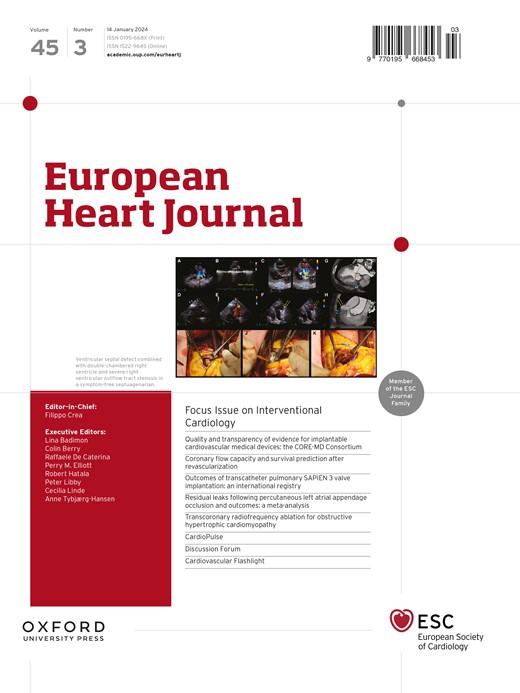慢性肢体威胁缺血血运重建术后的抗血栓治疗:欧洲心脏病学会主动脉和周围血管疾病工作组和欧洲心脏病学会心血管药物治疗工作组的科学声明。
IF 37.6
1区 医学
Q1 CARDIAC & CARDIOVASCULAR SYSTEMS
引用次数: 0
摘要
慢性肢体威胁性缺血(CLTI)被定义为缺血性休息疼痛,或无法愈合的溃疡,需要血管内或手术下肢血运重建术(LLR)。CLTI患者的下肢血运重建术具有较高的主要肢体不良事件(MALE)和主要心血管不良事件(MACE)风险。本科学声明是在系统回顾的基础上提出这一风险的。进行结构化文献检索,并由两位研究者独立评估文章。总共鉴定出1678篇文章,其中34篇纳入最后分析。只有三个随机对照试验(RCTs)涉及LLR后CLTI的抗血栓治疗。这些都没有证明任何抗血栓治疗方案优于其他方案。8项随机对照试验研究了包括CLTI亚组在内的外周动脉疾病人群LLR后的抗血栓治疗,并提示双重抗血小板治疗对肢体事件的益处。一项大型随机对照试验表明,阿司匹林和血管剂量利伐沙班的双途径抑制可降低MALE、MACE和计划外目标肢体血运重建的风险。来自22项观察性研究的数据表明,与单一抗血小板治疗相比,双重抗血小板治疗在LLR后的总生存期和无截肢生存期方面具有优势。对于LLR后CLTI患者应建议加强抗血栓治疗,以降低MALE和MACE的风险。在LLR后CLTI患者抗血栓治疗的随机对照试验很少。双途径抑制是唯一一项RCT显示LLR后MALE和MACE降低的方案。双重抗血小板治疗似乎与LLR后CLTI患者发生MALE的风险降低有关。本文章由计算机程序翻译,如有差异,请以英文原文为准。
Antithrombotic treatment following revascularization for chronic limb-threatening ischaemia: a scientific statement of the European Society of Cardiology Working Group on Aorta and Peripheral Vascular Diseases and the European Society of Cardiology Working Group on Cardiovascular Pharmacotherapy.
Chronic limb-threatening ischaemia (CLTI) is defined as ischaemic rest pain, or non-healing ulceration, requiring endovascular or surgical lower limb revascularization (LLR). Lower limb revascularization in CLTI entails a high risk of major adverse limb events (MALE) and major adverse cardiovascular events (MACE). This scientific statement addresses this risk based on a systematic review. A structured literature search was performed, and articles were independently evaluated by two investigators. In total, 1678 articles were identified, of which 34 were included in the final analysis. Only three randomized controlled trials (RCTs) addressed antithrombotic therapy in CLTI following LLR. None of these demonstrated superiority of any antithrombotic regimen over the other. Eight RCTs investigated antithrombotic therapy following LLR in populations with peripheral arterial disease including CLTI subgroups and suggest a benefit of dual antiplatelet therapy on limb events. One large RCT demonstrated that dual pathway inhibition with aspirin and vascular-dose rivaroxaban reduced the risk of MALE, MACE, and unplanned target limb revascularization. Data from 22 observational studies suggest a benefit of dual antiplatelet therapy on overall survival and amputation-free survival after LLR as compared with single antiplatelet therapy. Intensified antithrombotic treatment should be proposed in patients with CLTI following LLR to reduce the risk of MALE and MACE. Randomized controlled trials on antithrombotic therapy in patients with CLTI following LLR are scarce. Dual pathway inhibition is the only regimen for which an RCT demonstrated a reduction of MALE and MACE following LLR. Dual antiplatelet therapy appears to be associated with a reduced risk of MALE in CLTI following LLR.
求助全文
通过发布文献求助,成功后即可免费获取论文全文。
去求助
来源期刊

European Heart Journal
医学-心血管系统
CiteScore
39.30
自引率
6.90%
发文量
3942
审稿时长
1 months
期刊介绍:
The European Heart Journal is a renowned international journal that focuses on cardiovascular medicine. It is published weekly and is the official journal of the European Society of Cardiology. This peer-reviewed journal is committed to publishing high-quality clinical and scientific material pertaining to all aspects of cardiovascular medicine. It covers a diverse range of topics including research findings, technical evaluations, and reviews. Moreover, the journal serves as a platform for the exchange of information and discussions on various aspects of cardiovascular medicine, including educational matters.
In addition to original papers on cardiovascular medicine and surgery, the European Heart Journal also presents reviews, clinical perspectives, ESC Guidelines, and editorial articles that highlight recent advancements in cardiology. Additionally, the journal actively encourages readers to share their thoughts and opinions through correspondence.
 求助内容:
求助内容: 应助结果提醒方式:
应助结果提醒方式:


